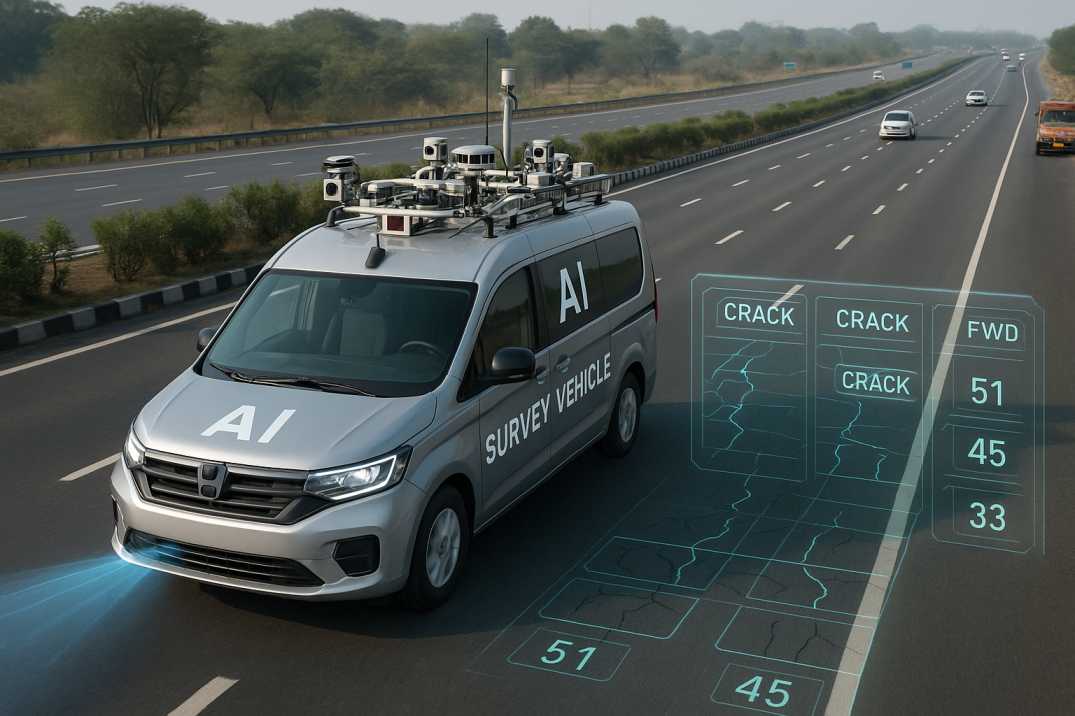Contact Us
RoadVision AI
Private Limited
Office No. 308 & 310, B Block
Ansal Chamber - 1, Bhikaji Cama Place,
Near Engineers India Limited (EIL) Bhawan, New Delhi - 110066
© 2024 | RoadVision AI | All rights reserved
India’s vast and ever-expanding road network demands more than just construction — it demands intelligent maintenance. Pavement distresses like cracking, rutting, and potholes are common but often go untreated due to manual inspections, outdated reporting systems, and lack of real-time data.
To bridge this gap, the Indian Roads Congress introduced IRC Code 115, a crucial guideline for structural evaluation of flexible pavements using the Falling Weight Deflectometer (FWD). While this was a breakthrough, the real transformation lies in digitizing IRC 115 using Artificial Intelligence (AI) and Big Data analytics.
In this blog, we explore the relevance of IRC:115, the challenges in traditional pavement testing, and how AI-based road management systems are reshaping the future of road maintenance in India.

IRC:115 provides a standardized framework for evaluating the structural health of flexible pavements using the Falling Weight Deflectometer (FWD). This test simulates wheel loading on the pavement and records the deflection to calculate the stiffness of each pavement layer. The data is then used to:
While effective, this method has traditionally relied on manual data entry, limited coverage, and delayed analysis.
Despite the robustness of IRC:115, its implementation is constrained by several on-ground challenges:
These challenges lead to inefficiencies, safety risks, and budget overruns in maintenance programs.
By digitizing IRC Code 115, India’s highway ecosystem is witnessing a shift toward automated, AI-powered pavement intelligence platforms like RoadVision AI. These systems enable real-time decision-making, nationwide scalability, and data-backed maintenance strategies.
Using high-resolution cameras, LiDAR, and IoT sensors, modern survey vehicles continuously collect pavement data. This includes:
This approach powers platforms like Pavement Condition Survey, enabling automated, scalable monitoring.
Computer vision models trained on IRC standards like IRC:82-2015 can:
By combining traffic volumes, climatic data, and historical FWD readings, AI models forecast where and when pavement failure may occur. This supports:
Digitized IRC 115 outputs can be directly plugged into Pavement Management Systems (PMS) and Pavement Maintenance Management Systems (PMMS), enabling:
IRC:82-2015 outlines standards for visual condition surveys, distress ratings, and maintenance triggers. Platforms like RoadVision’s Road Inventory Inspection bring these guidelines to life through:
Agencies like MoRTH, NHAI, and Smart Cities Mission are championing AI-driven road asset management. Tools such as RoadVision AI align with this national vision, supporting:
For insights on real-world deployments, explore the case studies showcasing large-scale surveys and digital maintenance planning.
India is transitioning from manual surveys to AI-based pavement intelligence systems. While IRC Code 115 laid the foundation, digitizing it is no longer optional — it’s essential.
RoadVision AI is transforming infrastructure development and maintenance by harnessing AI in roads to enhance safety and streamline road management. Using advanced roads AI technology, the platform enables early detection of potholes, cracks, and surface defects through precise pavement surveys, ensuring timely maintenance and optimal road conditions. Committed to building smarter, safer, and more sustainable roads, RoadVision AI aligns with IRC Codes, empowering engineers and stakeholders with data-driven insights that cut costs, reduce risks, and enhance the overall transportation experience.
Book a demo to see how you can digitize IRC 115 using RoadVision AI.
IRC:115 provides scientific guidelines for evaluating pavement strength using the Falling Weight Deflectometer (FWD), essential for planning overlays and strengthening.
AI enables automatic data collection, detects surface defects, predicts future deterioration, and integrates with PMS/PMMS, making implementation faster and more reliable.
Yes. IRC and MoRTH encourage using digital tools like FWD, condition surveys, and pavement management systems for highway infrastructure management.